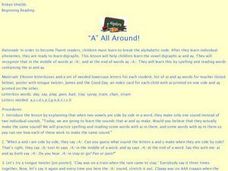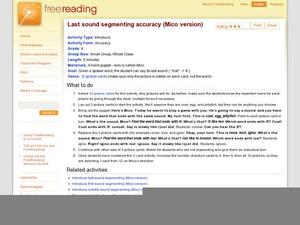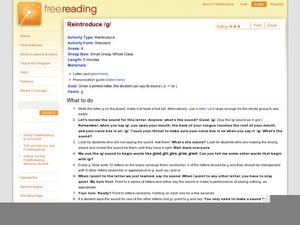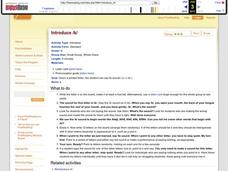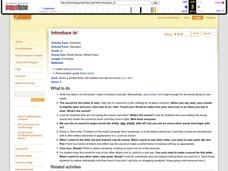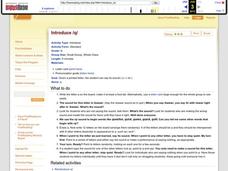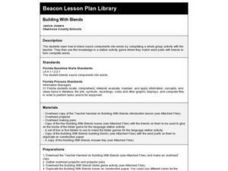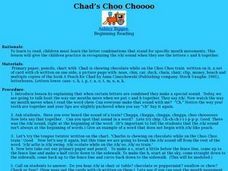Curated OER
"A" All Around
Spell and read words containing ai and ay. First and second graders identify vowel digraphs in written and spoken language. After a brief discussion on the combinations of letters that comprise digraphs, they practice reading and...
Curated OER
Phonics: Decode and Write Words with Blends
Kids see, say, then count the phonemes they hear in a series of simple words. They practice counting phonemes with the teacher, then sound out the same word on their own. As they count each phoneme they write it down on their paper. A...
Curated OER
Last Sound Segmenting (Mico Version)
Get your scholars excited about phonemes using Mico the puppet; they use the picture cards to examine three words at a time. Mico says the ending sound of one of the words, and learners determine which of them is a match. You'll want to...
Curated OER
Decode and Write Words with More Than One Syllable
Practice sounding out multi-syllable words with this scaffolded lesson. Learners decode words by segmenting them into phonemes and combining the sounds. Your lines are in bold here, but you can easily use this simply as an outline...
Curated OER
Introduce Onset-Rime Blending
Mico (or your favorite puppet) helps emergent readers recognize words from segmented phonemes. Explain to learners that he struggles with pronouncing words and needs their help. Model how Mico segments sounds in single-syllable words....
Curated OER
First Sound Segmenting Accuracy
What's the sound, Mico? Use your class' favorite puppet (in this example, Mico) to teach them about initial sounds in single-syllable words. Using the picture cards provided, choose three and lay them out in front of learners. When Mico...
Curated OER
Introduce /a/
Start your alphabet study strong using these strategies combining pronunciation, recognition, letter sound, and word examples focused on the letter a. Scholars examine the letter shape and listen to you pronounce the /aaa/ sound. As you...
Curated OER
Reintroduce /a/
What does the letter a sound like? Scholars practice with letter sound correspondence by honing their pronunciation of the /aaa/ sound. Use these helpful tips to explain how to make this sound if needed. Then, they brainstorm...
Curated OER
Reintroduce g
Synthesize pronunciation, recognition, letter sound, and word examples as scholars learn all there is about the letter g. They examine the letter shape and listen to you pronounce the hard /g/ sound. As you explain how this sound is...
Curated OER
Introduce Soft-C
Do your emerging readers know that letters sometimes borrow the sounds of other letters? Explore the soft /c/ sound, explaining that c has borrowed the sound from s. After giving scholars some examples of words that begin...
Curated OER
Introduce /k/
Explore the ins and outs of the letter k using these strategies combining pronunciation, letter recognition, and initial phoneme examples. Scholars examine the letter shape and listen to you pronounce the /k/ sound. Use these tips to...
Curated OER
Introduce /e/
Examine the most-used letter in the English language incorporating pronunciation, letter recognition, letter sound, and word examples for the letter e. Scholars examine the letter shape and listen to you pronounce the /eee/...
Curated OER
Introduce /Q/
Everything your pre-readers need to know about the letter Q is right here; this strategy combines pronunciation, letter recognition, sound, and word examples. Scholars examine the letter shape and listen to you pronounce the /kwww/...
Curated OER
Reintroduce /c/
Do you c what I c? Use these strategies combining pronunciation, letter recognition, and initial phoneme examples to examine the letter c with kindergartners. Scholars examine the letter shape and listen to you pronounce the soft...
Curated OER
Building With Blends
Understanding consonant blends is crucial for young readers. In this language arts lesson, learners examine consonant blends, and play the folder game, "Building With Blends," in small groups. The game is especially engaging!
Curated OER
What is a Haiku? How Do You Write a Haiku?
Haiku poetry is explored in this language arts lesson. Yong readers identify the characteristics of haiku and read several examples. Students make connections between their study of Japan and the poetic form of haiku, and they write...
Curated OER
Phonemic Awareness Worksheet
In this literacy worksheet, learners match the picture with the appropriate word phrase that is in the correct sound family for the four questions.
Curated OER
Everybody Get Ready
Learners identify and spell words containing the short /e/ sound. They rehearse a fun tongue twister which contains words emphasizing the short /e/ sound. They then read Red Gets Fed as a class. Have your group clap every time they hear...
Curated OER
Alexander said Achoo
Alexander asked for ashy amber apples! Have your young learners practice the /a/ sound with this tongue twister. Then learners will write the letter and participate in a book talk for A Cat Nap. Can they identify the target...
Curated OER
Aches and Pains
Being able to distinguish between short and long vowel /a/ sounds is an important skill for young readers. They are introduced to the vowel-consonant-e pattern that changes short vowel sounds into long vowel sounds. They practice reading...
Curated OER
Chad's Choo Choooo
Choo, choo! Do your youngsters like trains? After studying the target sound, have your learners read A Peach for Chad. Do a class read and an independent read to increase fluency. At the lesson's close, consider creating a ch train...
Curated OER
My Tooth is Loose
Elementary learners study the /th/ sound as a whole class. First they hear the sound and learn a tongue twister. After practicing together, they write the digraph on their practice paper. Then, to study the words in context, the class...
Curated OER
Beat the Heat
Review common digraphs with your early elementary schoolers. They identify the digraph /ea/ in written and spoken language. After a brief discussion, they apply the rule for identifying and spelling words containing the /ea/ digraph....
Curated OER
Peachy Teacup by the Stream
Help your kids distinguish between the sounds for short vowel /e/ and long vowel /e/. They are introduced to the vowel patterns that comprise long vowel sounds, with a particular emphasis on /ea/. They practice reading and spelling a...


